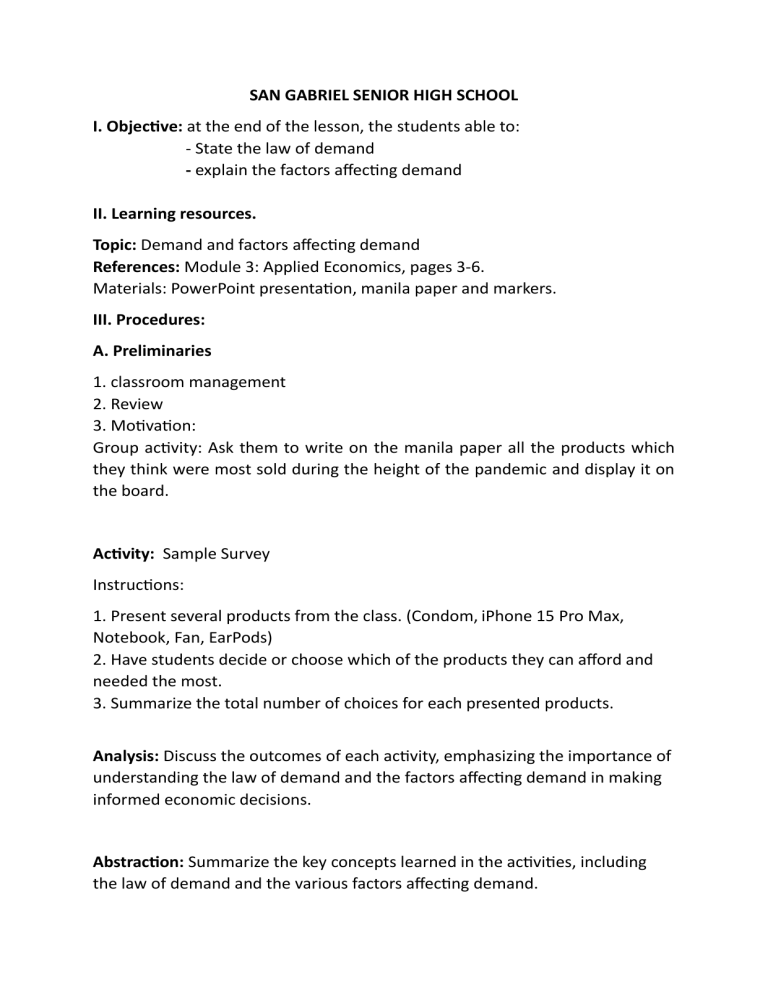
SAN GABRIEL SENIOR HIGH SCHOOL I. Objective: at the end of the lesson, the students able to: - State the law of demand - explain the factors affecting demand II. Learning resources. Topic: Demand and factors affecting demand References: Module 3: Applied Economics, pages 3-6. Materials: PowerPoint presentation, manila paper and markers. III. Procedures: A. Preliminaries 1. classroom management 2. Review 3. Motivation: Group activity: Ask them to write on the manila paper all the products which they think were most sold during the height of the pandemic and display it on the board. Activity: Sample Survey Instructions: 1. Present several products from the class. (Condom, iPhone 15 Pro Max, Notebook, Fan, EarPods) 2. Have students decide or choose which of the products they can afford and needed the most. 3. Summarize the total number of choices for each presented products. Analysis: Discuss the outcomes of each activity, emphasizing the importance of understanding the law of demand and the factors affecting demand in making informed economic decisions. Abstraction: Summarize the key concepts learned in the activities, including the law of demand and the various factors affecting demand. Application: Factors Affecting Demand - Group Discussion Materials: manila paper, markers Instructions: 1. Divide the class into small groups. 2. Assign each group a specific factor affecting demand, such as income, price of substitutes, or consumer preferences. 3. Each group should discuss and brainstorm examples and explanations of how their assigned factor affects demand. 4. Groups will present their findings to the class. Assessment: Teachers can assess students’ outputs based on the following criteria: Rubric: Criteria: Understanding of the assigned factor – 15 pts. Examples and explanations provided– 15 pts. Presentation skills– 10 pts. Points: 40 Prepared by: DELPHIN R. VIZCARRA Subject Teacher Checked by: ANA LINDA IMELDA S. CABANBAN Principal I a. Income The demand for goods and services also depends on the incomes of the people. The greater the incomes, the greater their demand will be. However, the effect of change in income on demand depends on the nature of the commodity under consideration. If a specific good is a normal good, then an increase in income leads to rise in its demand, while a decrease in income reduces the demand. But if the given commodity is an inferior good, an increase in income will then reduce the demand, and a decrease in income leads to rise in demand. b. Prices of substitute goods A substitute, or substitute good in economics is a product or service a consumer sees as the same or similar to another product. An increase in the price of substitute will lead to an increase in the demand for given commodity and vice-versa. For example, if the price of a substitute good like tea increases, the demand for a commodity such as coffee will rise as coffee will become relatively cheaper than tea. So, demand for a given commodity is directly affected by change in price of substitute goods. c. Number of consumers The market’s demand for a good is influenced by adding up the individual demands of the present as well as prospective consumers of a good at various possible prices. The greater the number of consumers of a good, the greater the market demand for it. The increase in consumers can happen when more and more favored substitute goods than a specific commodity. Then the number of substitute’s buyers will rise. When the seller expands to a new market to distribute goods, or when there is a growth in the population, the demand for a specific good can also escalate. d. Consumers’s taste and preferences Tastes and preferences of the consumer have a direct influence on the demand for a commodity. This can be applied for products in fashion, customs, habits, etc. For example, if a commodity in fashion is on trend and is preferred by the consumers, the demand for such a commodity will definitely rise. On the other hand, demand for it will fall, if the consumers have no taste or preference for that commodity. E. Prices of complementary goods A complement refers to a complementary good or service used in conjunction with another good or service. Usually, the complementary good has little to no value when consumed alone, but when combined with another good or service, it adds to the overall value of the offering. An increase in the price of complementary goods leads to a decrease in the demand for given commodity and vice-versa. For example, if the price of a complementary good like condensed milk increases, then demand for given commodities as coffee will slightly fall as it will be relatively costlier to use both the goods together. So, demand for a given commodity is inversely affected by change in price of complementary goods.


